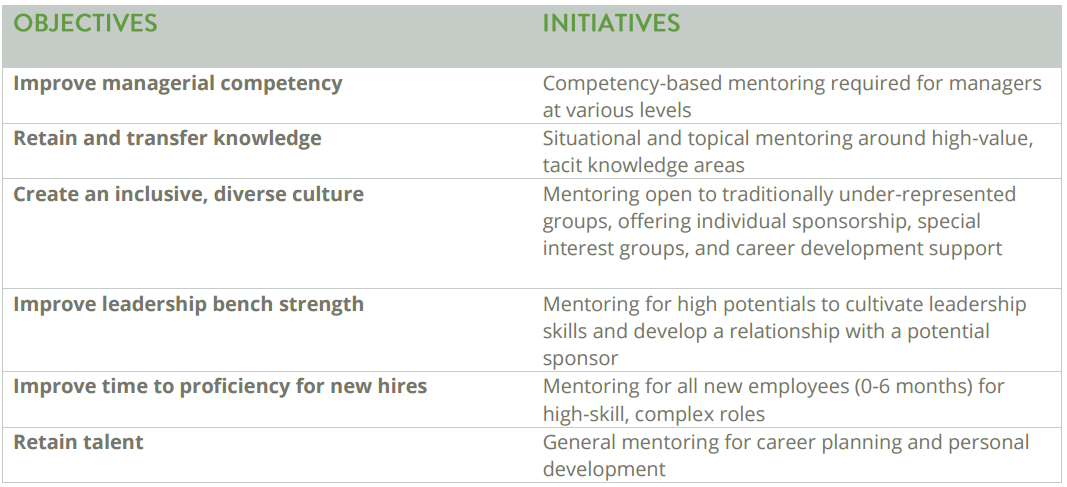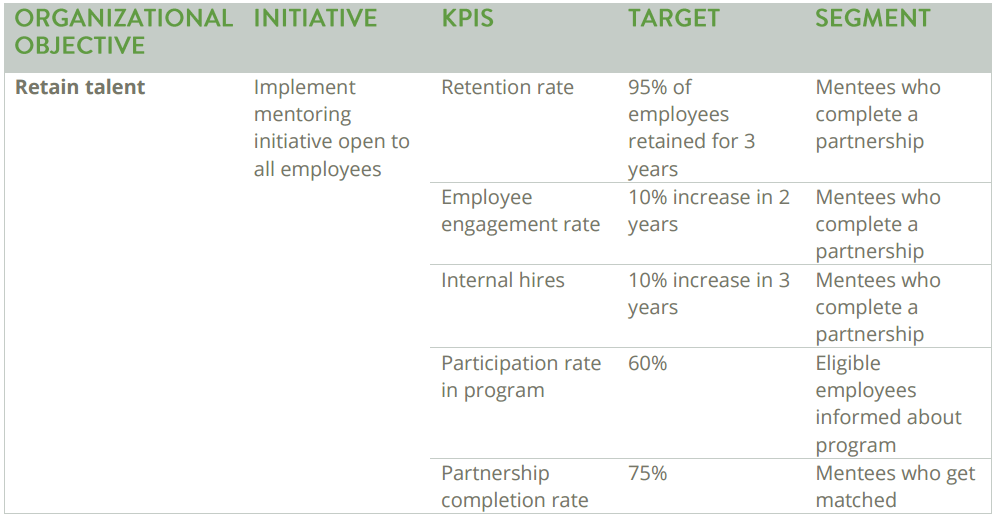To harness ongoing support for your program, measuring mentoring success is key. Conducting a top-down mentoring program evaluation should include organizational objectives, key performance indicators (KPIs), targets, and segments. In order to understand the true ROI of mentoring, you must plan, design and measure with intention.
First, consider your mentoring initiative in the context of a higher-level business need. Next, set realistic KPIs and targets. Finally, elaborate on your strategy with segments and specific measurement tactics. Watch our quick video to learn more:
The high-level objective is the “big picture” that answers the question, “Why does this initiative exist?” Likely mentoring will be just one of several strategies to achieve an organizational objective. Here are a few objectives and their common corresponding mentoring initiatives:
How to Set Up Your Mentorship Objectives
When building out your mentorship program objectives, it’s important to be intentional and accountable to what you want to achieve with your mentoring strategy. Clear intention will help you identify the data points that will point to success or failure.
1. Determine the purpose of your mentoring program
Why does this program need to exist? The answer to that question will determine your organizational objectives, which are the goals for your mentorship initiative. Understanding this big picture view will help you set appropriate Key Performance Indicators (KPIs), program targets and segments.
Examples of mentoring program objectives:
- Retain top-performing employees
- Improve leadership skills
- Increase diversity in leadership and management roles
- Boost new employee competency
- Upskill and transfer key institutional knowledge
- Create a more supportive culture
Get mentoring resources straight to your inbox. Subscribe today!
2. Choose KPIs for your mentorship objectives
Once you’ve derived a general concept of an initiative to attain your organizational objective, use Key Performance Indicators (KPIs) to specify measures of success. Consider setting KPIs that look at several areas:
- Acquisition of participants
- Behavior within the program
- Outcomes at an organizational level
This will help you determine cause-and-effect of mentoring successes or failures. For example, if you know employee satisfaction is high among those who have completed a partnership, but membership in the program is dismal, then membership is the dial you will need to turn in order to achieve the high-level objective. The table below provides some examples.
3. Establish mentoring program targets and segments
Once your KPIs are clear, make your success metrics bounded and specific by establishing targets and segments. Targets are measures of success, and segments are the populations, behaviors, or outcomes to analyze against your target. Through this process, you will turn high-level objectives into SMART objectives: specific, measurable, attainable, realistic, and time-bound. Below is an example of what a complete, SMART mentoring business analysis might look like:
A good practice is to measure improvement for a specific segment against an organizational baseline or another segment. Groups to compare against each other may include:
- Employees who were not in the mentoring program
- Employees who participated in the program but did not set goals
- Employees who participated in the program and set specific goals
4. Make Mentorship Program Objectives Specific and Time-Bound
To evaluate the success of your mentorship program with accuracy, it’s important to set goals that are specific and time-bound. It’s not enough, for example, to set a general goal of retaining key talent. To make the goal measurable, you would need to specify a time-bound target, such as:
- retain 90 percent of software engineering talent for two years
- increase retention of Black women employees by 25 percent over the next three years
Increasing specificity will help hold your program accountable to impact, and better indicate which KPIs you should pay attention to.
Examples of Mentorship Program Objectives
- Improve knowledge transfer: To make your goal specific and time-bound, identify the groups that will share knowledge, the specific knowledge to be shared, and the time period in which the transfer will take place. For example: employees with a tenure of three-plus years will mentor new employees on proprietary systems to increase time to competency by 20 in the first six months after hire.
-
- Increase leadership diversity: Add a percentage and deadline to your KPI to make this objective a SMART goal. For example: increase the representation of women and BIPOC employees at director level by 20 percent in the next five years.
-
- Create a more supportive culture: Quantifying culture can be tricky, so you’ll need to drill down into specifics when building your target. Consider how you’ll measure this KPI: will you use employee satisfaction surveys, performance metrics that look at which tasks employees avoid or progress toward DEI goals? Whichever KPIs you choose, remember to include numbers and deadlines when setting your targets. For example: over the next two years, achieve a 25 percent increase in the number of employees who answered ‘yes’ to the employee satisfaction survey question, ‘Do you feel valued by your organization?’
-
Practical Ways to Measure Key Performance Indicators
Once you know what to measure, you will need specific ways to evaluate mentoring. Engage stakeholders in a conversation about how to capture meaningful metrics. For KPIs that track acquisition and behavior, such as program participation and completion, look at user workflows and segments. Acquisition might look at what percentage of eligible users actually got matched. Behavior might track whether they set goals, achieved goals, met regularly, developed a rapport, or perceived value from the experience.
- Tip: If a metric relies on reported behavior, you will need incentives in order to get an accurate measurement. The best incentives are built into your culture & expectations. For example, tie mentoring into improvement plans, leadership programs, or promotion requirements – then make certain activities or check-ins required for credit for these programs. If mentoring is fully optional, people will still benefit – but they won’t all want to track their activities.
Also think about practical ways to measure outcome-based KPIs. In the case of a talent retention program, you might track how long people stay with the organization, or you might instead choose to measure predictors of retention, such as employee attitudes. Following are examples of ways you can measure employee attitudes:
- Survey how engaged employees are toward both their work and the organization. Understand levels of enthusiasm, drive, and passion about individual contributions and the organization.
- Survey how committed employees are to the organization. Do employees feel attached to the organization and driven to stay on board?
- Survey managers as to apparent engagement levels within their teams.
- Survey satisfaction with career development over time.
- Survey employee perception of organizational culture in a few key areas:
- Does the organization treat learning and adaptability as an objective?
- Is the organization invested in employees’ professional development and skill acquisition?
- Does it seem like the capability of people is always improving?
- Is the organization honest, open, compassionate, and trustworthy place to work?
For the above tactics, be sure you have a way to track improvement. One way to do this is to capture data for those in your target audience who haven’t been mentored, then compare that data to that of those who have completed a mentoring partnership. Alternatively, try capturing data for your mentoring population before they begin the program, and then capture it again upon program completion and once more six months later.
Tools for Measuring Mentorship Evaluation
Once you’ve defined and developed your mentorship program goals and metrics, you can set up the mechanics of how you will evaluate your mentoring program and measure mentoring success.
Surveys
Quantitative: Measuring hard metrics like retention and promotion rates can help you quantify the success of your mentoring programs by comparing specific segments. For example, you might want to compare the promotion rate of program participants who set goals versus those who did not.
Qualitative: These surveys measure soft metrics like job satisfaction, perceptions of productivity, and other subjective measures of success. Qualitative survey questions may be open-ended, e.g., “What is your biggest challenge at work right now?” or close-ended, e.g., “If additional training became available, would you sign up for it? Yes/No/Unsure.”
Reporting
Enrollment: Keep a pulse on enrollment numbers in comparison to the total pool of mentoring participants you envisioned.Maximize registration with tailored branding and integrations with HRIS and collaboration tools for fast and easy program enrollment.
Matching: Of those enrolled, track the percentage that actually get matched. Building a match report (or keeping track of it via software) will enable you to see how many mentors and mentees you’re engaging. This type of reporting can also illuminate where you might need to do more promotion (i.e. if you have 100 mentees, but only 30 mentors).
Participation: Use virtual mentoring integrations like video conferencing or direct messaging integrations to keep participants engaged remotely or in-person. Tracking these engagement activities will illustrate what tools or modes your participants are connecting through best.
Business Objectives: Besides programmatic goals, make sure you’re tying mentoring participation back to the metrics that matter to your organization – retention, advancement, DEI, skill development and beyond.
- What’s the retention rate of mentoring participants in comparison to non-participants in your organization?
- What’s the promotion rate of mentoring participants in comparison to non-participants in your organization?
Measuring your mentoring performance is vital in order to demonstrate impact to stakeholders and leadership.
Achieve Mentoring Program Success with Chronus Mentoring Software
Once you’ve defined and developed your objectives and mentoring metrics, you can set up the mechanics of how you will measure mentoring success. This is where software can help. Chronus mentoring software provides several features, including:
- Analytics: track program and individual connection progress
- Reports: view real-time performance and export details for further analysis
- Surveys: acquire feedback from participants throughout all phases of program





